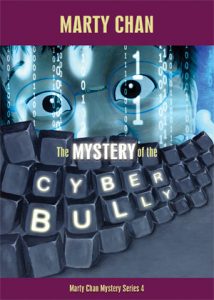 The Mystery of the Cyber Bully
The Mystery of the Cyber Bully
by Marty Chan
Thistledown Press, 2010
ISBN 978-1-897235-82-9
$10.95, 215 pp, ages 8 – 11
www.thistledownpress.com
What school-aged child doesn’t know about bullies and bullying? This is an action-packed mystery aimed at younger readers with a focus on the emergence of bullying through the perceived anonymity of the Internet. It is filled with metaphors and similes, allowing children to create vivid images of the story in their mind making the answer to the mystery itself the only struggle throughout the book.
Marty, Remi and Trina are three friends who are well known in the grade six class for solving mysteries. The trio work together—armed with their friendship, walkie-talkies and sleuthing skills—each contributing their unique gifts to solve the mystery of the cyber bully. It begins with just one student in the class, then suddenly it seems as though everyone is the target of emails, messages or online posts aiming to embarrass or hurt them. Samantha is picked on because of her fashion, Mikayla because of her social life, Nathan, his karate skills. No one is safe.
This book brings awareness to bullying, as Marty says, “Bullies don’t need a reason. They need victims.” (p. 54). The book is also useful for introducing the dangers of the Internet and helping kids understand how to get help if they know that someone is being bullied online: “Cyber bullies pick on their victims through the Internet. At least with a real bully, you were safe at home. With cyber bullies, home was the worst place to be, unless you didn’t have a computer, because they could send you messages anywhere and at any time. Often, they hid their identities. Some kids believed this was because schools had strict no cyber-bullying policies, but I believed it was because cyber bullies were cowards.” (p. 52)
Classroom Connections: This is an excellent short text to open discussions on Internet safety, character education (including social groupings, good friends and bad friends) and anti-bullying strategies and would make a great novel study before November’s Bullying Awareness and Prevention weeks. You could also use this book to investigate dialogue in reading and writing as well as using similes and metaphors (especially around April for poetry month). Reading Comprehension Strategies: Making Predictions, Inferring, Visualizing.
Review by Amanda Parker.
This review is from Canadian Teacher Magazine’s Jan/Feb 2012 issue.









